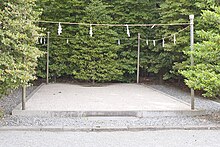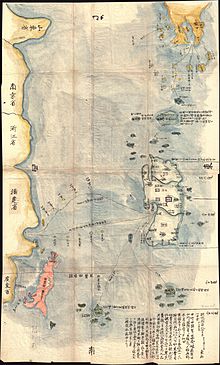User:Jinki/Sandbox-Rishiri
| This is a Wikipedia user page. This is not a Wikipedia article or the talk page for a Wikipedia article. If you find this page on any website other than Wikipedia, you are looking at a mirror site. This page may not be up to date, and the user who made this page may have no relationship with any site other than Wikipedia. The original page can be found at https://simple.wikipedia.org/wiki/User:Jinki/Sandbox-Rishiri. |
This page has been removed from search engines' indexes.

Ryukyu draft[change | change source]

Geography[change | change source]
Included in the geography of Japan was the chain of islands in the East China Sea south of Kyushu from Tanegashima to Hateruma which lies close to the 24th parallel of north latitude.[1]
History[change | change source]

From 1609 through 1945, Ryūkyū Province (琉球国, Ryūkyū-no kuni) was an ambiguous province of Japan in the area of the Okinawa Prefecture and other islands at the Pacific edge of the East China Sea.[2]
1609-1872[change | change source]
The 1609 invasion of Ryūkyū by Japanese forces was a significant event.[3]
After 1609, the Ryukyuan kings were forced to be vassals of the Shimazu clan of Satsuma Province and the islands became a province of Japan.[4] The Tokugawa ordered cadastral maps of every "kuni" in Japan -- including Ryūkyū -- in Keicho (1596–1615), Shoho (1644–1648), Genroku (1688-1704) and Tenpō (1830–1844); however, unlike the other maps which are listed as "-no-kuni", the ones for Ryukyu are listed as "-koku".[5]
Ryūkyū maintained an appearance of independence.[6] The Ryukyuan kings and the kingdom's government remained in place; however, in 1636 Satsuma ordered the Shō dynasty to use of the title kokushi (administrator of the country) in official documents instead of Ryūkyū-koku Chuzan-ō (king of Chuzan, country of Ryukyu). The use of Ō (king) was restored in 1712.[7] From 1610 to 1850, Ryukyuan missions to Edo were received as ambassadors.[8]
1872-1879[change | change source]
Soon after the Meiji Restoration in 1868, an Imperial military force was garrisoned at Naha.[9] From 1872 through 1879, the dual nature of the kingdom and its rulers was changed with the development of the Ryūkyū Domain[10] and province.[11]
1879-1947[change | change source]
In 1879, Okinawa Prefecture (Okinawa-ken) was established.[12] At the same time, the province continued to exist for some purposes. For example, Ryūkyū is explicitly recognized in 1899 in treaties (a) between Japan and the United States and (b) between Japan and the United Kingdom.[13]
Demographics[change | change source]
In the Edo period and early Meiji period, the people living in the Ryukyu Islands were surveyed by officials of Satsuma Domain.
| Year | Population | Notes |
|---|---|---|
| 1632 | 108,958 | [14] |
| 1636 | 111,669 | [14] |
| 1659 | 112,764 | [14] |
| 1665 | 110,241 | [14] |
| 1670 | 110,211 | [14] |
| 1672 | 116,483 | [14] |
| 1677 | 122,213 | [14] |
| 1684 | 129,995 | [14] |
| 1690 | 128,567 | [14] |
| 1699 | 141,187 | [14] |
| 1706 | 155,108 | [14] |
| 1707 | 155,261 | [14] |
| 1713 | 157,760 | [14] |
| 1721 | 167,672 | [14] |
| 1729 | 173,969 | [14] |
| 1761 | 188,530 | [14] |
| 1772 | 174,211 | [14] |
| 1795 | ||
| 1800 | 155,650 | [14] |
| 1826 | 140,565 | [14] |
| 1852 | 132,678 | [14] |
| 1871 | 166,789 | |
| 1873 | 166,789 |
Dispute[change | change source]
The status of the islands from 1609-1879 is the subject of an on-going dispute.[15] For example,
- "In the report of the Joint Japan-China History Committee (31 January 2010), the Japanese insisted that Ryukyu was under effective control of the Satsuma domain from the 17th century and that this fact was known to China, while the Chinese persevered that Ryukyu was an independent state until 1879, when Ryukyu was annexed by Japan."[15]
Shrines and temples[change | change source]
Naminoue Shrine at Naha on the island of Okinawa was the chief Shinto shrine (ichinomiya) of the Ryukyus.[16] In 1890, the shrine was recognized in the system of State Shinto. It is among the ranked, nationally significant shrines or Kanpei-shōsha (官幣小社).[17]
References[change | change source]
- ↑ Satow, Ernest. (1882). "The Geography of Japan" in Transactions of the Asiatic Society of Japan, Vols. 1-2, p. 89., p. 34, at Google Books; excerpt, "The whole number of islands in the Japanese group, exclusive of the four main islands, is stated to be over three thousand .... South of Kiu-shiu extends another long chain, which may be said to begin with Tane-ga-shima opposite to the province of Osumi and to end with Hateruma, the most southerly of the Yayeyama group, which lies close to the 24th parallel of north latitude .... The ordinary maps of Japan do not include any of the islands south of Yaku no Shima; Fassbender, p. 483.
- ↑ See Kerr, George H. (1953). Ryukyu Kingdom and Province before 1945; Fassbender, Bardo et al. (2012). The Oxford Handbook of the History of International Law, p. 483; excerpt, "The status of Ryukyu is ambiguous when looked at from the perspective of modern European international law, although there appears to have been no serious issues concerning the status of Ryukyu at that time."
- ↑ Nussbaum, Louis-Frédéric. (2005). "Ryūkyū Islands" in Japan Encyclopedia, p. 801, p. 801, at Google Books; Fassbender, p. 483.
- ↑ Rabson, Steve. (1997). "Assimilation Policy in Okinawa: Promotion, Resistance, and "Reconstruction," New directions in the study of Meiji Japan: Proceedings of the Conference on Meiji Studies, held at Harvard University from May 4-6, 1994 (Helen Hardacre, ed.), p. 639; Toby, Ronald P. (1991). State and Diplomacy in Early Modern Japan: Asia and the development of the Tokugawa bakufu, pp. 45-46, citing manuscripts at the Historiographical Institute of the University of Tokyo; excerpt, "Ieyasu granted the Shimazu clan the right to "rule" over Ryukyu ... [and] contemporary Japanese even referred to the Shimazu clan as 'lords of four provinces', which could only mean that they were including the Ryukyuan kingdom in their calculations".
- ↑ National Archives of Japan, "Genroku Kuniezu,"; retrieved 2013-5-17.
- ↑ Smits, Gregory. (1999). Visions of Ryūkyū: Identity and Ideology in Early-Modern Thought and Politics, p. 28.
- ↑ Fairbank, John King. (1968). The Chinese world order: traditional China's foreign relations, p. 312 n13.
- ↑ Toby, pp. 45-50.
- ↑ Kerr, George. (1958). Okinawa;History of an Island People, p. 4.
- ↑ Matsumura, Wendy. (2007). Becoming Okinawan: Japanese Capitalism and Changing Representations of Okinawa, p. 38; excerpt, "March 27, 1879 marks the birth of Okinawa Prefecture and the death of the short-lived Ryukyu domain, which itself came into being on September 14, 1872, replacing the Ryukyu kingdom."
- ↑ Matsuo, Kanenori Sakon. (2005). The Secret Royal Martial Arts of Ryūkyū, p. 40., p. 40, at Google Books; excerpt, "In 1872, Ryukyu Province was formed, and in 1874, ties were broken with Qing China. Due to this, Japanese and Chinese tensions continued. In 1879, the Meiji government occupied the royal castle by force, and abolished the province, simultaneously establishing Ryukyu Prefecture".
- ↑ Nussbaum, "Okinawa-ken" in Japan Encyclopedia, pp. 746-747, p. 746, at Google Books.
- ↑ US Department of State. (1906). A digest of international law as embodied in diplomatic discussions, treaties and other international agreements (John Bassett Moore, ed.), Vol. 5, p. 759; note that the corresponding Japanese texts may show that 藩 was translated as province.
- ↑ 14.00 14.01 14.02 14.03 14.04 14.05 14.06 14.07 14.08 14.09 14.10 14.11 14.12 14.13 14.14 14.15 14.16 14.17 14.18 14.19 Yoshio Oguchi, "Demographics of Satsuma Domian", Reimeikan Chōsa Kenkyū Hōkoku (no. 11), pp. 87–134 (1998); Oguchi, "Demographics of Satsuma Domian and early modern Ryūkyū", Reimeikan Chōsa Kenkyū Hōkoku (no. 13), pp. 1–42 (2000).(in Japanese)}.
- ↑ 15.0 15.1 Fassbender, Bardo. (2012). The Oxford Handbook of the History of International Law, p. 483.
- ↑ Ponsonby-Fane, Richard. (1959). The Imperial House of Japan, p. 127.
- ↑ List of Kankokuheisha (官国幣社), p. 3; retrieved 2013-3-21.
Other websites[change | change source]
![]() Media related to Ryukyu Province at Wikimedia Commons
Media related to Ryukyu Province at Wikimedia Commons
Population density[change | change source]
- United Nations, "Population density and urbanization"; compare Werner Staub and Dirk Krischenowki. "GeoTLDs – Diversity, Multilingualism and Local Content," Internet Governance Forum, Oct 30 – Nov 2, 2006, p. 31 n4; excerpt, "The United Nations has set up its own classifications scheme: a "big city" is a locality with 500,000 or more inhabitants; a "city" is a locality with 100,000 or more inhabitants; an "urban locality" is a locality with 20,000 or more inhabitants; a "rural locality" is a locality with less than 20,000 inhabitants ..."; retrieved 2013-4-24
__________
- Ponsonby-Fane, 1915, p. 2.
2.—SUT-ZEI (B.C. 581-549). Little or nothing is known or Kamanunakahamin but from the very outset we meet with the successic difficulties which: down to quite modern times have rex the Imperial House in twain. In this case Tagishimim no-MikOto, a natural son of the Emperor Jimmu by Princess whom he had married before his victorious progre eastward, not perhaps unnaturally considered that he ha good claims to the throne. (Mr. Aston points out that •must have been 100 years old at this time.) Kamuyaemimi-no-Mikoto, the eldest son of the lat Emperor by his Kogo, wishes to kill the claimant but i too frightened to do so and therefore requests his young brother to undertake the task. The younger brother i made of sterner stuff and makes no difficulty about I whereupon the elder brother, professing that he is unworth to succeed, cedes the Throne. - The Emperor established his court at Kazuraki I Yamato and died at the age of 84. It will be noticed that though the Emperor Jimm died in 585-this reign does not commence till 581.
3.—ANNEI (B.C. 549-511). As far as we are told this Emperor was the only soin of the preceding sovereign Suizel. He made Katashiha in Kawachi his capital and died at the age of 57.
4—ITO KU (B .C. 510-477) His Majesty was the second son of the last Emper We are not told why he was preferred to lus elder brothe'
